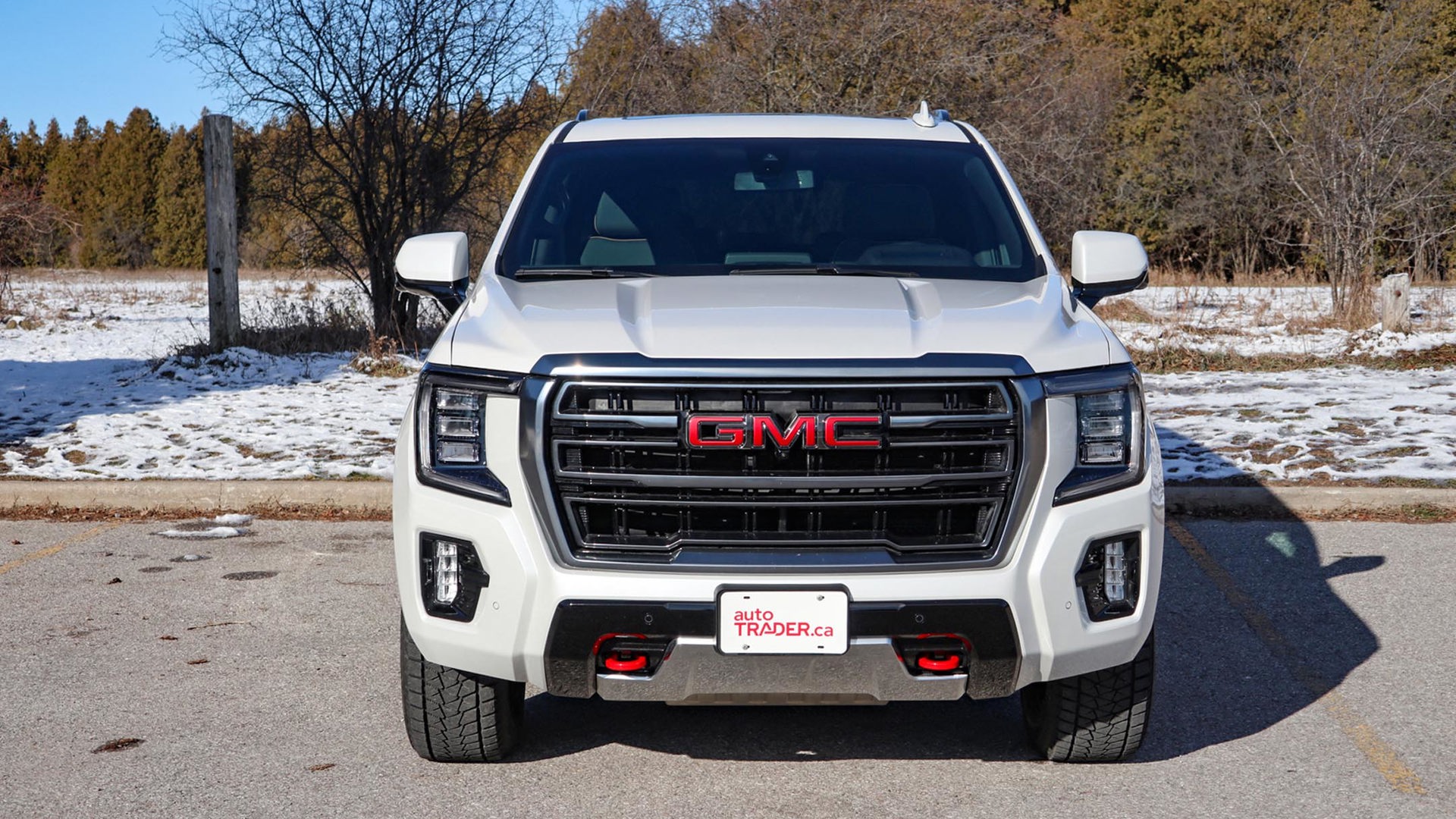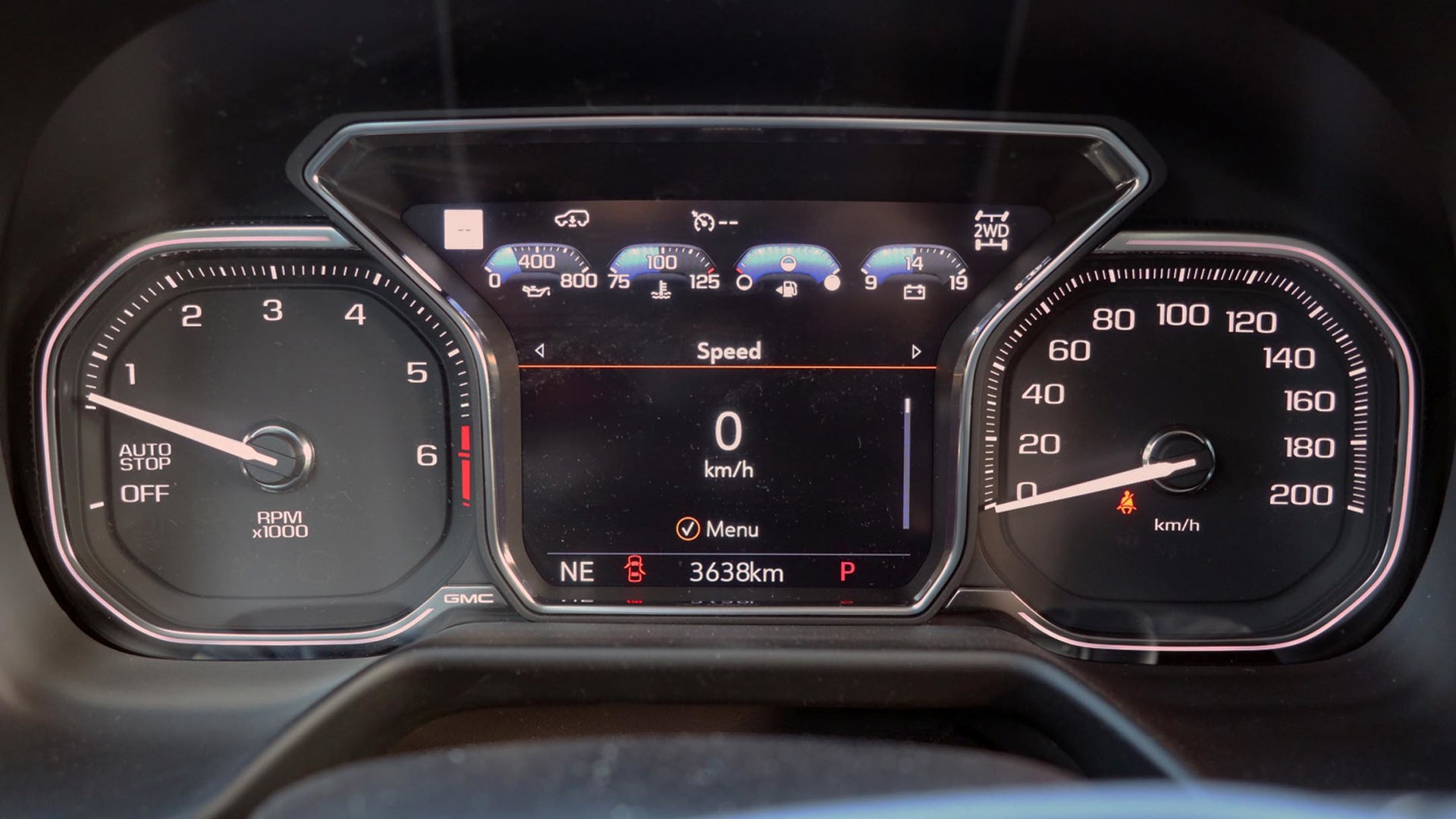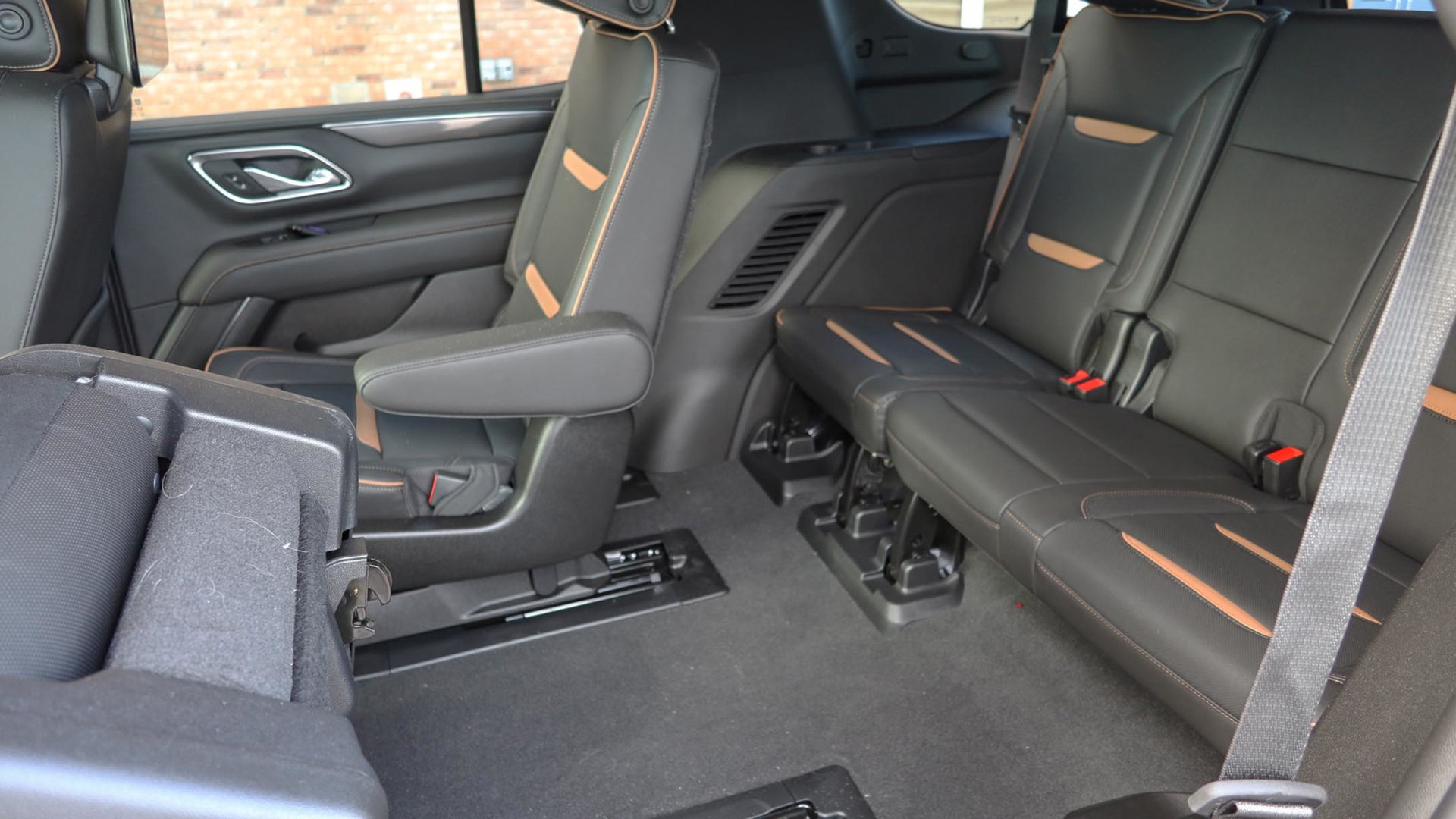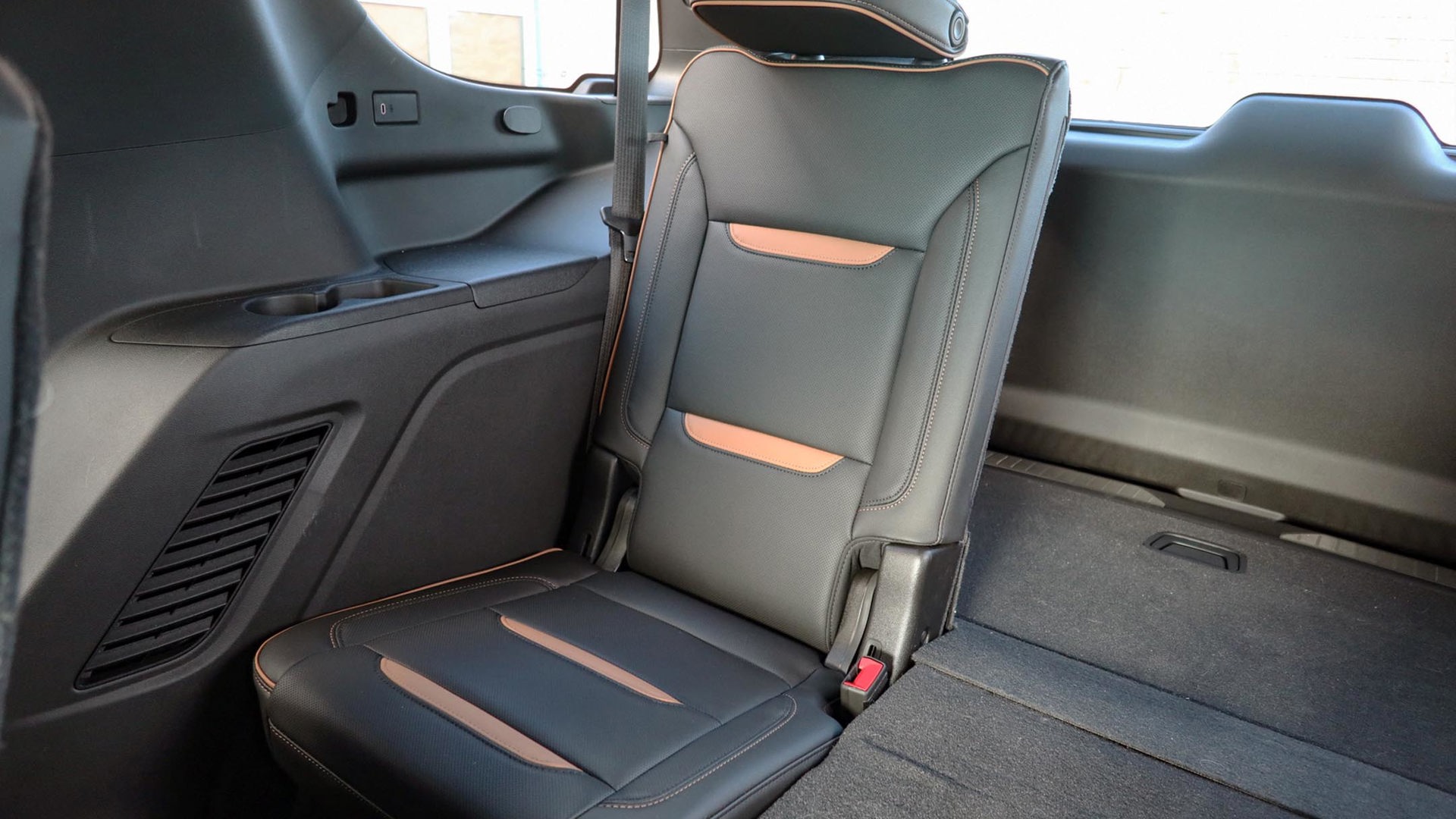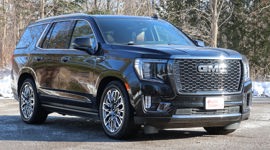 AutoTrader SCORE
AutoTrader SCORE
-
STYLING8/10
-
Safety8/10
-
PRACTICALITY9/10
-
USER-FRIENDLINESS9/10
-
FEATURES8/10
-
POWER8/10
-
COMFORT9/10
-
DRIVING FEEL8/10
-
FUEL ECONOMY8/10
-
VALUE7/10
Other than minivans, relatively few three-row vehicles truly are viable for adult passengers in the third row.
One that is – and especially now thanks to a redesign – is the 2021 GMC Yukon. A longer wheelbase and a new independent rear suspension gives this big SUV even more legroom for that rear row, along with more cargo space.
I had the standard Yukon, though it’s also available as the extended-length Yukon XL, both of which are mechanical twins to the Chevrolet Tahoe and Suburban. The Yukon comes in two trim levels in rear-wheel drive, starting at $57,998, and a quartet of four-wheel-drive trims, beginning at $61,298. I had the AT4, a name GMC reserves for trucks and sport-utes with extra off-road-specific features. It starts at $74,698, while mine was garnished with several options that took it to a very hefty $86,833 before freight and taxes.
Styling: 8/10
Overall, I tend to prefer GMC’s styling over similar Chevrolet models, and the Yukon is no exception. It’s a big-enough vehicle to pull off that massive grille, along with the chiselled head- and fog light surrounds. The front skid plate and red tow hooks are part of the AT4 trim level, although my tester’s mantle of White Frost Tricoat was extra and added $1,195 to the price tag.
The Yukon’s squared-off profile preserves its impressive headroom right to the rear. It was easier to get into my truck thanks to its power-deployed running boards, with lights that come on when the boards drop to see where you’re stepping in the dark. That wasn’t my only perimeter lighting: the GMC logo in the grille also lit up, although it was an extra $550 for that dealer-installed option.
Safety: 8/10
Neither the United States National Highway Traffic Safety Administration (NHTSA) nor the Insurance Institute for Highway Safety (IIHS) had crash-tested the 2021 makeover at the time of this writing, so I’m basing my score on what’s available in it. Standard equipment includes blind-spot monitoring, lane-keep assist, emergency front braking with pedestrian detection, rear pedestrian alert, and the rearview camera that’s mandatory on all new vehicles.
Practicality: 9/10
For most needs, the Yukon is practicality on the hoof. There is a great deal of small-item storage up front, including a huge open cubby and a deep console bin. At the back, the large tailgate opens to a low liftover, so it’s relatively easy to reach in to deposit or retrieve cargo. The rear glass also flips up separately. My tester had an adaptive air suspension that could be set to automatically lower when the Yukon was in park, making it even easier to access.
There’s a shallow bin under the floor, and the second- and third-row chairs fold flat – electrically in my tester – to form a flat floor, and you get between 722 L and 3,480 L of space, depending on what seats are up or down. If that isn’t enough, the Yukon can tow as much as 3,810 kg (8,400 lb).
User Friendliness: 9/10
The Yukon uses buttons and dials for most of its functions, and they’re simple to use. There are dials for the temperature and fan speed, and for the stereo volume and tuning. The centre touchscreen has large, intuitive icons, and it’s all easy to use.
Some of the functions that are packed into the touchscreen on other vehicles are hard buttons here, including the heated and ventilated seats, heated steering wheel, and best of all, the head-up display. Rather than page through screens to find the head-up controls – because the display’s height often has to be adjusted for different drivers – there’s a simple toggle switch to move it up or down. The only control I don’t like is the gear selector, which consists of buttons on the side of the centre stack. A lever or a dial is much easier to use.
Features: 8/10
The Yukon AT4 comes well-equipped, as it should for $75,000. The standard-features list includes auto-dimming mirrors, hands-free tailgate (with an emblem projected onto the ground to show you where to kick your foot to activate it), automatic high-beam headlights, and rain-sensing wipers. Inside, you get 12-way power-adjustable heated and ventilated front seats, heated second-row chairs, power-folding third row, 120-volt power outlet, and my favourite feature, a heated steering wheel. The 10.2-inch centre touchscreen includes OnStar, a Wi-Fi hotspot, and satellite radio.
That’s only the start, of course, and among other items I had an AT4 Premium Plus package, for an additional $9,795 that added such features as a maximum trailering package, dual-screen rear-seat entertainment system, panoramic sunroof, power running boards, and a “Premium Capability” package with electronic limited-slip differential and adaptive air suspension.
Power: 8/10
Most Yukon trim levels, including my AT4, come with a 5.3L V8 engine, making 355 hp and 383 lb-ft of torque. The top-level Denali exclusively uses a 6.2L V8 for 420 hp and 460 lb-ft of torque, and both use a ten-speed automatic transmission.
I’ve driven both engines, and while the 6.2L gives you more bragging rights, the smaller V8 more than gets the job done. It’s got a lot of Yukon to move around, but it’s quiet and smooth, and has more than enough acceleration for highway passing. GM uses cylinder deactivation, which shuts off fuel to portions of the engine when full power isn’t required for better mileage. Some engines have active fuel management (AFM), which shuts off the same cylinders each time, but the Yukon’s two engines use dynamic fuel management (DFM), which shuts them off in a number of different patterns, depending on what’s most efficient. It’s absolutely seamless and has no detrimental effect on performance.
Comfort: 9/10
Size matters, and the redesigned Yukon’s extra length ups this comfortable truck’s game. Its first- and second-row chairs were always nice, and while you’ll still want to prioritize those for your own seat, the third row gets much better. That’s partly due to the extra legroom afforded by the stretch, and to the independent rear suspension in place of the previous solid axle. That lowers the rear floor, which in turn means your chin is farther away from your knees back there.
The front seats are bolstered and supportive, and in the AT4 are both heated and ventilated. You can also select whether to heat the entire seat or just the seatback, which is nice if you’d like some warmth on a sore spine but don’t need your butt cooked as well.
Driving Feel: 8/10
This is a big vehicle and you never forget that, but it handles well and has a tight turning circle. The new independent rear gives it an even smoother ride, as does my tester’s optional air suspension. This is a vehicle to get you and several passengers to a far-flung destination in long-distance comfort, or to tackle the potholes on the daily commute.
The four-wheel-drive system includes high and low range settings for off-road conditions. Those shouldn’t be used on hard pavement where the system can bind, but there is an automatic setting that can be. I find it useful for greasy or wet roads, or on stretches of road where there are alternating patches of snow and dry asphalt.
Fuel Economy: 8/10
The Yukon with 5.3L V8 is rated by Natural Resources Canada (NRCan) at 14.3 L/100 km in the city, 11.8 on the highway, and 13.1 L/100 km in combined driving. That’s a slight improvement over the last-generation 2020 Yukon, rated at 13.8 L/100 km in combined driving. In real-world driving, I got 13.9 L/100 km in my week with it.
Those numbers are good for a big, truck-based vehicle, and better than those of competitors like the V8-powered Jeep Grand Cherokee and Dodge Durango (14.1 L/100 km); the Nissan Armada (15.4); and Toyota Sequoia (16.4). It’s only slightly worse than the rating of the V6-powered Ford Expedition.
Value: 7/10
At a starting price of $61,298 with four-wheel drive, the Yukon offers a lot of features but it’s still a hefty chunk of change. Even so, getting into some of its full-size, body-on-frame competitors will take even more out of your wallet, depending on how you check off your options list. The Nissan Armada starts at $66,098, the Toyota Sequoia at $69,790, and bring $92,500 if you want a Lincoln Navigator.
Those prices are no doubt why so many people are getting into unibody three-row sport-utilities – the Kia Telluride, for example, starts at $44,995 – along with the better fuel efficiency of these lighter-weight machines. But for those who want the Yukon’s interior space, or its towing and payload capacity, you still get a lot for your money.
The Verdict
General Motors basically set down the roots of the sport-utility segment with its first Chevrolet Suburban Carryall, an eight-passenger truck-based wagon that debuted for 1935. This full-size segment is a relatively small one overall, but GM’s entries still sell very well in it. With this makeover, the Yukon emerges with more comfort, better efficiency, and enough to put it on the cross-shop test-drive list.
| Engine Displacement | 5.3L |
|---|---|
| Engine Cylinders | V8 |
| Peak Horsepower | 355 hp @ 5,600 rpm |
| Peak Torque | 355 hp @ 5,600 rpm |
| Fuel Economy | 14.3 / 11.8 / 13.1 L/100 km city/hwy/comb |
| Cargo Space | 722 / 2,056 / 3,480 L behind 3rd/2nd/1st row |
| Model Tested | 2021 GMC Yukon 4WD AT4 |
| Base Price | $74,698 |
| A/C Tax | $100 |
| Destination Fee | $1,900 |
| Price as Tested | $88,833 |
|
Optional Equipment
$12,135 – Power-release second-row seats, $430; White Frost Tricoat paint, $1,195; AT4 Premium Plus Package (maximum trailering package, four-corner adjustable air suspension, premium capability package with active response 4WD, rear media and navigation package, panoramic sunroof, and power running boards with lighting), $9,795; Illuminated front GMC logo, $550; Illuminated GMC mirror emblem, $165
|
|








